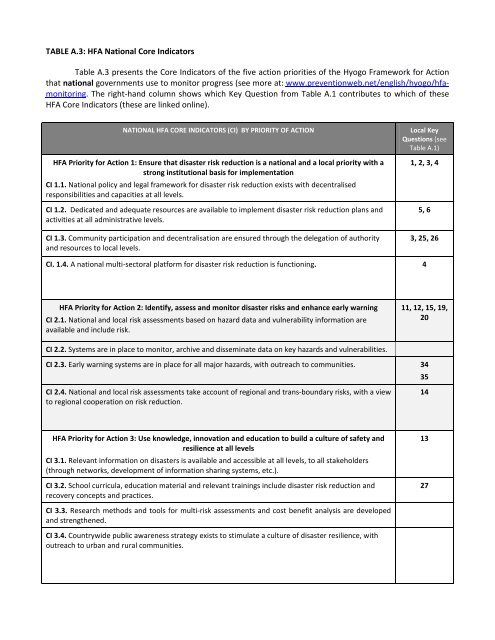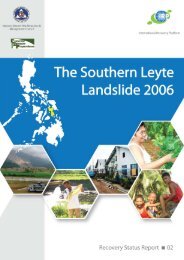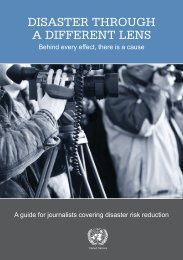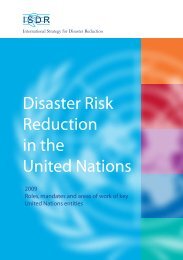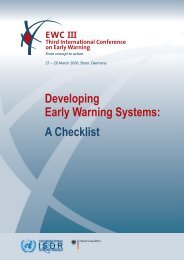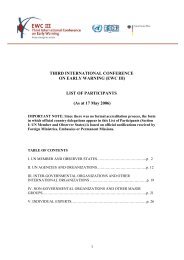Overview of Local Government Self-Assessment Tool (LGSAT
Overview of Local Government Self-Assessment Tool (LGSAT
Overview of Local Government Self-Assessment Tool (LGSAT
Create successful ePaper yourself
Turn your PDF publications into a flip-book with our unique Google optimized e-Paper software.
TABLE A.3: HFA National Core Indicators<br />
Table A.3 presents the Core Indicators <strong>of</strong> the five action priorities <strong>of</strong> the Hyogo Framework for Action<br />
that national governments use to monitor progress (see more at: www.preventionweb.net/english/hyogo/hfamonitoring.<br />
The right-hand column shows which Key Question from Table A.1 contributes to which <strong>of</strong> these<br />
HFA Core Indicators (these are linked online).<br />
NATIONAL HFA CORE INDICATORS (CI) BY PRIORITY OF ACTION <strong>Local</strong> Key<br />
Questions (see<br />
Table A.1)<br />
HFA Priority for Action 1: Ensure that disaster risk reduction is a national and a local priority with a<br />
strong institutional basis for implementation<br />
CI 1.1. National policy and legal framework for disaster risk reduction exists with decentralised<br />
responsibilities and capacities at all levels.<br />
CI 1.2. Dedicated and adequate resources are available to implement disaster risk reduction plans and<br />
activities at all administrative levels.<br />
CI 1.3. Community participation and decentralisation are ensured through the delegation <strong>of</strong> authority<br />
and resources to local levels.<br />
CI. 1.4. A national multi-sectoral platform for disaster risk reduction is functioning. 4<br />
HFA Priority for Action 2: Identify, assess and monitor disaster risks and enhance early warning<br />
CI 2.1. National and local risk assessments based on hazard data and vulnerability information are<br />
available and include risk.<br />
CI 2.2. Systems are in place to monitor, archive and disseminate data on key hazards and vulnerabilities.<br />
1, 2, 3, 4<br />
5, 6<br />
3, 25, 26<br />
11, 12, 15, 19,<br />
20<br />
CI 2.3. Early warning systems are in place for all major hazards, with outreach to communities. 34<br />
CI 2.4. National and local risk assessments take account <strong>of</strong> regional and trans-boundary risks, with a view<br />
to regional cooperation on risk reduction.<br />
HFA Priority for Action 3: Use knowledge, innovation and education to build a culture <strong>of</strong> safety and<br />
resilience at all levels<br />
CI 3.1. Relevant information on disasters is available and accessible at all levels, to all stakeholders<br />
(through networks, development <strong>of</strong> information sharing systems, etc.).<br />
CI 3.2. School curricula, education material and relevant trainings include disaster risk reduction and<br />
recovery concepts and practices.<br />
CI 3.3. Research methods and tools for multi-risk assessments and cost benefit analysis are developed<br />
and strengthened.<br />
CI 3.4. Countrywide public awareness strategy exists to stimulate a culture <strong>of</strong> disaster resilience, with<br />
outreach to urban and rural communities.<br />
35<br />
14<br />
13<br />
27


